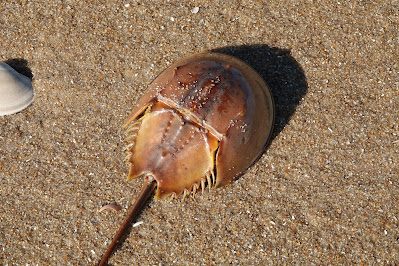The Diamondback Terrapin is a turtle of the brackish waters of salt marshes, estuaries and tidal creeks, all of which the Eastern Shore of Maryland has in abundance, as do all of the Chesapeake Bay states. My dead diamondback rolled on to an Ocean City beach along the salty Atlantic Ocean during tide change. So why was it there? It had been dead for awhile, but not for a super long time. On September 22nd (a week prior to my visit), Hurricane Ophelia arrived (from Emerald Isle, NC) along the Eastern Shore of Maryland. I hypothesize that its brackish habitat was flooded and forced the turtle out to the salty ocean - where it probably met its death.
Even dead, the terrapin was beautiful. The pattern on its shell reveals this. It was probably quite an old turtle as well; at least old enough to have barnacles on its shell. Additionally, female Diamondback terrapins are larger than males. I think this turtle was probably female because it was about 8 to 9 inches in size.
Just so everyone knows, the Diamondback terrapin is in trouble. That its numbers are decreasing should not surprise most. This is probably why I have never seen a living Diamondback terrapin. Please don't pick up and take home to sell or raise. Wild Diamondback terrapins do not adapt well to captivity. Please do not buy a Diamondback Terrapin from a seller. This is a practice, amongst many practices involving wild turtles, that needs to stop. Only licensed and dedicated rehabbers and licensed naturalists who are supporting Diamondback terrapin survival and recovery in the wild should keep these turtles.
The rising sun on the morning I found the Diamondback Terrapin. And in the western sky, the moon.
On to other topics, this jellyfish was the size of a dinner plate. I wanted to put it back in the water (I had no idea if it was dead or alive; it appeared quite fresh), but I was strongly advised against trying. It was well beyond the tide line.
A couple of final photos to complete this post.








